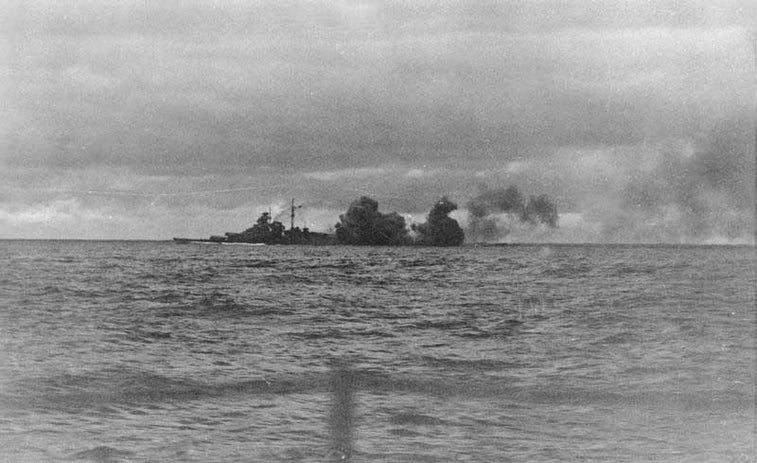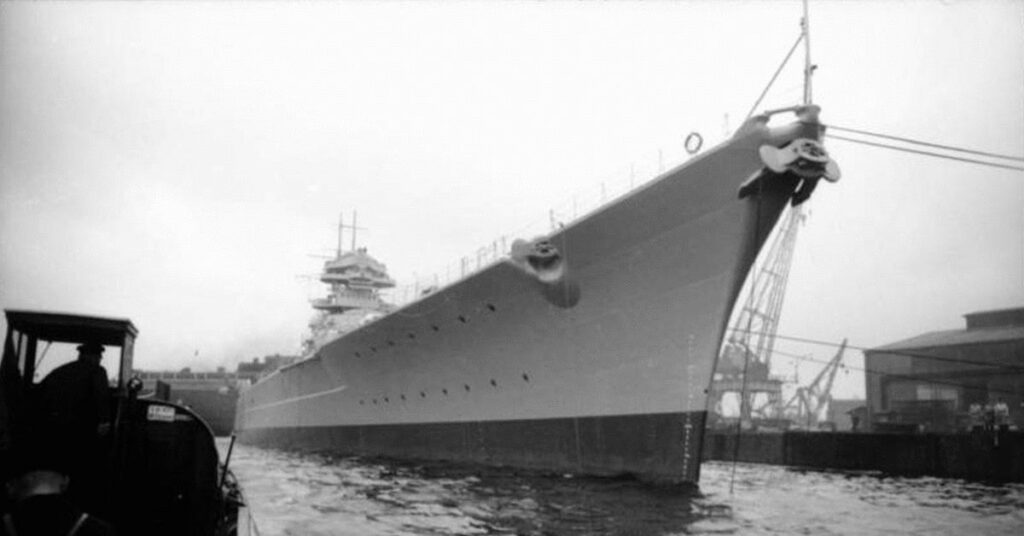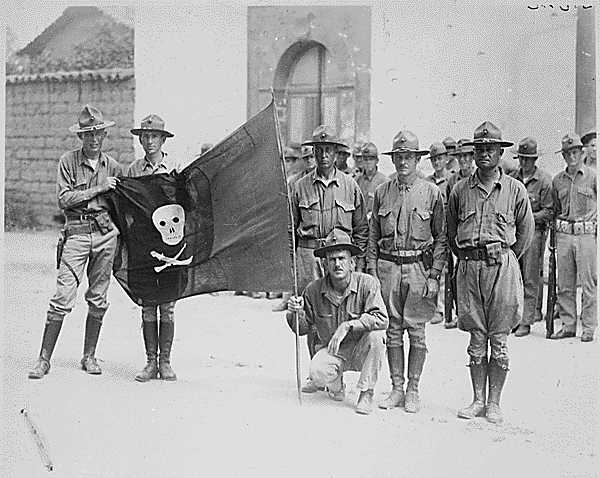In the early days of World War II, battleships were still considered kings and all of the combatants hunted for their enemies’ greatest ships. The battleship Bismarck, the largest battleship in commission at the start of 1941, was the pride of the German Kriegsmarine and an epic combatant. Britain desperately wanted to sink her before she could break into the open Atlantic.
Luckily for Britain, a badly timed, badly encoded radio transmission allowed British warships to find and kill the vessel.

RELATED: THE FORGOTTEN CODE BREAKING WOMEN OF WWII
In May, 1941, the U.S. and Russia had not yet joined the Allies as combatants, and Britain had already been pushed entirely off the continent. Morale was low in Great Britain, and its control of the seas was challenged by German U-boats that preyed upon convoys from the U.S.
One of Britain’s greatest fears was that Germany would starve the island kingdom out, potentially by sending more and larger ships into the Atlantic to prey on shipping. One of the most frightful possibilities was the Bismarck, a massive craft that was, at the time, the largest battleship in active service in the world (Japan’s Yamato-class and America’s Iowa-class would later beat its records).
The Bismarck had 16-inch guns and thick armor, and it could hit most convoys with impunity if it ever broke out of the Baltic and North seas. In May, 1941, it attempted to do just that.

The Bismarck left port on May 18 and attempted to slip out undetected. It made it through the North Sea with the Prinz Eugen as well as a number of smaller vessels. But when the flotilla passed between Denmark and Sweden into the North Sea, Norwegian resistance members and Swedish forces got a good look at the ships, and someone passed the report to Britain.
It’s unsure how much detail Britain received (Norwegian resistance members only identified “two unidentified major ships”), but British naval officers immediately suspected that the Bismarck was breaking out.
On May 21, the ships were spotted, and the British gave chase. The full story is great, from British cruisers tailing the massive vessel to attackers hiding in fog banks to when the Bismarck sank Britain’s pride and joy, the HMS Hood, with a single hit from the Bismarck’s main guns. The YouTube channel Extra History has a great series on the hunt, available here for all who want to watch it.
But we’re going to skip ahead to the final days of the chase.
By dawn on May 25, the Hood was sunk, the Prinz Eugen had escaped into the Atlantic, and the Bismarck had evaded the British cruisers in pursuit. But the Bismarck had been wounded and was now leaking oil across the ocean, limiting its range and speed.
The British, more desperate than ever to prevent the Bismarck from joining the war in the Atlantic as well to avenge the loss of the Hood, had called every available ship into the hunt.
But the days of naval maneuvering had left the Bismarck hundreds of miles out to sea, and the British didn’t know if the ship would head to Norway or France for repairs. Britain didn’t have enough ships to search both routes.
RELATED: THE WWII SPY ROOTS OF THE PHRASE ‘SECRET SQUIRREL’
The British commander sent most of the fleet north to search the route to Norway, leaving one battleship and a few other vessels within range of the route to France.
This problem was compounded when the Bismarck made a monumental mistake, sending two 30-minute radio transmissions, but some of the British intercept officers made a mistake and pinpointed the transmission as coming from the route to Norway, when the transmission actually came from the route to France. It would take them hours to catch the mistake.
At this moment, the Bismarck’s path into France was relatively clear. The German vessel had the lead, and the British fleet was headed the wrong way. But the rumors of the Bismarck’s fighting had made it to the continent, and a concerned father made one of the worst mistakes of the war.
The general had a son on the Bismarck, and he asked after his son’s status. The request was transmitted to the Bismarck, and the Bismarck responded. Then, that response was relayed back to the general. It said the Bismarck had suffered no casualties and was now headed to Brest, a port city in France.
When the message was relayed, though, it was done on a Luftwaffe Enigma machine with only four wheels instead of the more secure, five-wheel model used by the Admiralty. The British quickly decoded the message, and the entire British fleet turned back south to intercept the Bismarck before it could reach Brest.
On May 26, the HMS Ark Royal, an aircraft carrier, was chasing down the Bismarck as night came on. It was mere hours till darkness would halt any more attacks. By morning, the Bismarck would be under the protection of Luftwaffe planes taking off from France.
It was now or never, and the Swordfish planes flying from the Ark Royal had just enough time for two attacks. But the first attack was a ridiculous catastrophe. The British planes made a mistake, attacking the British ship chasing the Bismarck instead of the Bismarck itself. Luckily, they were equipped with magnetic detonators that set off the torpedoes as they hit the water.
The Swordfish returned to the Ark Royale to re-arm, and then headed back out for Britain’s last chance at the Bismarck before it was safely in France.

The planes chased down their quarry, and the Swordfish flew into the teeth of the Bismarck’s guns. The rounds shredded the canvas wings of the planes, but the planes managed to drop a spread of torpedoes anyway.
There were two hits. One struck the Bismarck’s armor belt and did little damage, the other struck low in the water but did no visible damage. The Swordfish pilots turned home in dismay.
But when they landed, they learned glorious news. The Bismarck had been in a hard turn to port when the second torpedo struck, and the strike had knocked out rudder control. Since the Bismarck had been in a hard turn at the time, it was now stuck turning in tight circles in the Atlantic, out of range of Luftwaffe protection.

The rest of the British fleet barreled down on the stricken foe, and eventually, four battleships and cruisers were circling the Bismarck, pounding it with shell after shell. They knocked out turrets, they shredded the decks, and they terrified the crew.
It only ended when the British fleet ran low on fuel. It was under orders to sink the Bismarck at all costs, so as most of the ships headed to refuel, the HMS Dorsetshire was left to finish the job. It dropped torpedoes into the water, and finally, the Bismarck suffered holes beneath the waterline. The Bismarck sank. The pride of the German fleet was done. Just over 100 sailors survived of the 2,200-man crew.
If the general had loved his son a little less, or, you know, if signals officers had been more careful to use the best available encryption or leave the ship’s destination out of the message, the Bismarck likely would have made it to France without further damage.
Read more from Sandboxx News:
- Pippa Latour: The WWII spy turned humble hero
- ‘Greyhound’ is a masterful tale of war at sea in the North Atlantic of WWII
- Crazy photos from the WWII battles in the Arctic that you’ve never heard of
- Habakkuk: Churchill’s aircraft carrier made of ice
- The special operations that paved the way for D-Day
This article by Logan Nye was originally published by We Are the Mighty. Follow WATM on Facebook.
Feature image: German Federal Archives




